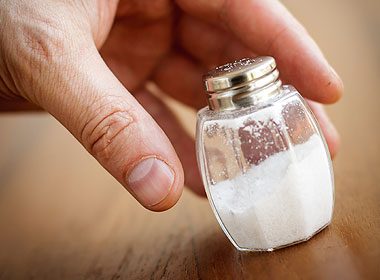
Take it with a pinch of salt! The truth behind a few salty myths
For decades we’ve been told to hold back on the salt. But the average Australian is still consuming almost twice the recommended amount.
To highlight World Salt Awareness Week, (Monday 29 February – Sunday 6 March 2016) Public Health Nutritionist Clare Farrand, from The George Institute for Global Health, sets out to tackle the seven most common myths about salt.
Myth: I don’t add salt to my food, so I don’t eat much salt
Truth: it’s not just about what you sprinkle on your meals. About 75% of the salt we eat is already in everyday foods such as bread, cheese, processed meats, cereals and sauces, so many of us are eating too much salt without even knowing.
Myth: I don’t have high blood pressure so I don’t need to eat less salt
Truth: Most people can benefit from eating less salt, even people within the normal range of blood pressure, are still at risk of developing high blood pressure. By limiting your salt intake you can reduce your risk of developing high blood pressure.
Myth: There’s no real evidence that salt is a major contributor to high blood pressure
Truth: The evidence for the effect of salt on blood pressure is overwhelming. Overviews of more than thirty randomised trials in which people were assigned to eat different amounts of salt showed clear benefits of reducing salt consumption on blood pressure. Even a modest reduction in salt intake for just four weeks or more significantly reduces blood pressure.
Myth: I only use sea salt and that’s healthier than table salt
Truth: Whilst table salt is highly processed, rock and sea salts are just as high in sodium chloride as table salt, regardless of their healthy image. There is no ‘healthy’ salt. Salt is salt is salt.
Myth: You can tell when a food is salty because it tastes salty
Truth: Some foods that are high in salt don't taste particularly salty. Pasta sauces, bread, biscuits & cakes can all contain hidden salt.
Myth: Food with less salt tastes bland
Truth: After just three weeks of eating less salt, your taste buds become more sensitive. Essentially you will get the same flavour from less salt. You can also use other ingredients like herbs and spices, wine, onions, chillies and lemons, to add extra flavour.
Myth: I need more salt because I exercise a lot and ‘sweat it out’
Truth: You only lose a small amount of salt in sweat, and as we all eat more than we need, most people won’t need to take on any extra.
Salt and Health Facts
- In Australia, the estimated average consumption of salt is 8-9grams of salt per day. That’s 75000 tonnes of salt each year.
- We only need about 1g of salt for normal physiological function, but we are eating far more. The World Health Organisation recommends that we limit our salt intake to less than 5g/day for adults, and less for children.
- Salt increases our blood pressure and puts us at risk of heart disease and stroke.
- 1 in 3 people in Australia have high blood pressure
- High blood pressure accounts for 60% of all strokes, and 50% of all heart disease.
- 3500 deaths each year could be prevented if we reduced average daily salt intake by 3 grams per day. This would lead to a 22% reduction in deaths from strokes and a 16% reduction in deaths from coronary heart disease.

